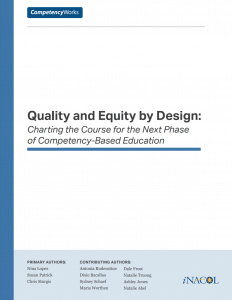Charting the Course for the Next Phase of Competency-Based Education: Strengthening Understanding
CompetencyWorks Blog
This is the eighteenth post in the blog series on the report, Quality and Equity by Design: Charting the Course for the Next Phase of Competency-Based Education.
 It is up to us, to all of us who believe in and are implementing competency education, to take on the issues of equity, quality, meeting students where they are and ensuring that policy is fit for purpose. This blog series has explored each of the four issues that are paramount to address in order for competency education to fulfill its promise to provide and sustain a better educational system for our next generation. Piecemeal design, poor implementation, turning our backs on the practices that we know will provide greater equity, failing to respond to the needs of students, and continuing to rely on outdated policy structures will result in competency education fading away except for a few shining district examples and a collection of innovative school models. These are not issues for other people to do — but for everyone within their roles, organizations and networks to actively pursue to deepen our knowledge and develop collective responses.
It is up to us, to all of us who believe in and are implementing competency education, to take on the issues of equity, quality, meeting students where they are and ensuring that policy is fit for purpose. This blog series has explored each of the four issues that are paramount to address in order for competency education to fulfill its promise to provide and sustain a better educational system for our next generation. Piecemeal design, poor implementation, turning our backs on the practices that we know will provide greater equity, failing to respond to the needs of students, and continuing to rely on outdated policy structures will result in competency education fading away except for a few shining district examples and a collection of innovative school models. These are not issues for other people to do — but for everyone within their roles, organizations and networks to actively pursue to deepen our knowledge and develop collective responses.
Below are a number of ideas for action steps that can be taken to advance our knowledge and effectiveness in these issues. Some of these are action steps that iNACOL and CompetencyWorks will take on; others are initiatives for other organizations to consider or require substantial collaboration. Please consider these action steps as a starting point for discussion and not a finite list. Certainly, there are many ways to undertake these action steps in ways that build on the values of competency education and strategically engage other partners. For example, there are ways to put into practice the ideas below that will either build a diverse leadership or continue to emphasize white privilege. It is up to all of us to overcome the historical patterns of race and racism in the United States — in our professional lives, in our communities and in our schools.
The Challenge: It is critical that we strengthen the resources available to help people understand what competency education is and how it can support personalized learning. If people do not understand that competency-based education requires changes in both culture and structure of schools, there is a risk that it will be approached as simply a technical reform or a set of limited practices. To effectively convert from the traditional system to a competency-based one, educators will need to understand how the pieces of the new system fit together.
The field of personalized learning is also overburdened by multiple understandings, some focusing on technology and others that are much more student-centered that emphasize ways to engage and motivate students. As these ideas are clarified, we anticipate that the ideas of competency education and personalized learning will eventually merge into the next generation education system.
Recommended Action Steps to Generate Shared Understanding
- Revise the working definition of competency education based on lessons learned over the past seven years and develop a clear logic model.
- Develop and use message-tested communication strategies designed for different stakeholders, including video resources about what competency education looks like and resources to support adaptive leadership strategies to engage people in discussion, not just buy-in.
- Create resources that help educators who are unable to travel to visit a competency-based school to learn more about competency education in peer-to-peer learning opportunities including videos, online discussions, and tools.
- Invest in further avenues for educators to learn about competency education including funding positions at districts with the most mature systems to coordinate site visits, funding travel for site visits, creating detailed documentation (written and video) of the models, and developing more detailed guidebooks.
Stay tuned for future blogs in this series that explore action steps for advancing competency-based education on issues of equity, quality, meeting students where they are, and policy – or download the whole report.
Follow this blog series:
- Quality and Equity by Design
- Readiness for College, Career and Life: The Purpose of K-12 Public Education Today
- Why A Competency-Based System Is Needed: 10 Ways the Traditional System Contributes to Inequity
- How Competency-Based Education Differs from the Traditional System of Education
- Competency-Based Education and Personalized Learning Go Hand-In-Hand
- Building Shared Understanding of Quality through Design Principles
- 5 Quality Design Principles for Culture
- 7 Quality Design Principles for Structure
- 4 Quality Design Principles for Teaching and Learning
- Designing a Competency-Based System for Equity
- An Equity Framework for Competency-Based Education
- Meeting Students Where They Are So That Everyone Masters Learning
- How Do We Know Where Students Are?
- 3 Common Features of Competency-Based Systems that Meet Students Where They Are
- 6 Strategies to Navigate System Constraints in Competency-Based Education
- 4 Threshold Concepts for Policy to Tackle in the Long Term to Support Competency Education
- Ways That States Are Beginning the Shift to Competency-Based Education